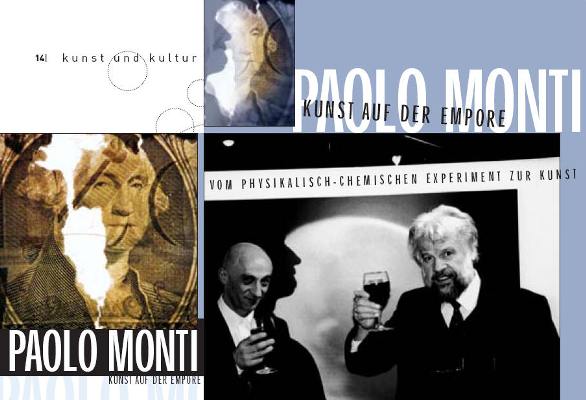|
PAOLO MONTI:
from physical-chemical experiment to art
14 | a r t & c u l t u r
e
|
uni’kon | Alexia
Sailer II.2001

The shape seems to be
permeated by mysterious force fields.
Cloudlike configurations of yellow-orange shades fill the face and
bare arms of the figure. A shirt and cap can be deciphered, defined
by patches of lilac-blue.
The realisation dawns: here you see the image of a man taken with a
thermal camera. The principle of this procedure is the heat from the
instrument as it depicts temperature; the warmer the object the more
its pictorial representation glides into a deep orange. The colder,
the colour shifts to blue. What was displayed up there in the
gallery of the university is perhaps a scientific discovery created
through image? Yes, but not only.
"Four-Dimensional", was the title of the exhibition of Italian
artist Paolo Monti.
An exposition that combines science, or rather, art and
experimentation.
Thermal images are a part of Paolo Monti's work in the 90s. It is
with this technique that he creates portraits. However, no longer
portraits depicting the immutable appearance that tends to affix
characteristic features of a person in the image. Paolo Monti,
through scientific experimentation, utilizing mirrors of mercury,
creates portraits beyond the individual, no longer tied to a
personality.
The question arises: what is art in Monti? The answer is conceivably
to be found in a work in which the shadow of the profile of the
artist overlaps with the profile of the artist in a thermal image.
And this alludes to the anecdote of the beginnings of painting, when
a woman drew the silhouette of her beloved who went away to war.
Monti presented conceptual art "à la Duchamp," as explained by
Friedemann Malsch, director of the Kunstmuseum of Liechtenstein,
when introducing the show.
This aspect is also apparent in the second series of works - to
which Paolo Monti is committed - namely Money. Or rather, decay and
decomposition of money. Works such as the installation "Take a
sniff, it smells good!" create hilarity and respire profound
meaning.
To watch the dissolution of a dollar bill and see evidence of the
collapse of money, fixed on CIBA chrome, awakens curiosity and of
course brings with it many implications. Even so, was it not a bit
exaggerated to put Monti on the same level of multilayered
innovation and deeply reflective horizon of meaning as a Marcel
Duchamp?
Professor Nikolaus Läufer, economist at Constance, correlates the
work of Monti with a particular monetary theory. Läufer recalls the
so-called "Schwundgeld" (play money), invented by Silvio Gesell in
the 1930s. At the time, the concern was that saving money was
damaging the economy. To kick-start the financial system, money must
deteriorate so that the fortunate owners of capital would invest
their wealth immediately, before the collapse.
The implications were clear: Paolo Monti also produces a form of
hypothetical currency: on one hand the money destroys itself through
chemical decomposition; in the case of "Take a sniff, it smells
good! " the observer, by pressing a button, becomes actively
destructive. Of course the artist himself had his hands in the game,
creating a texture, by slicing off the top edges of Italian 50,000
lira banknotes and encapsulating them between two sheets of
plexiglass.
Monti, subsequent to all this work, from the "magical dissolution"
of money, arrives at the multiplication of money; as Friedemann
Malsch explained chuckling during the Vernissage: Paolo Monti went
to the bank with "circumcised bills" and exchanged them
unceremoniously for new ones.
Alexia Sailer
|